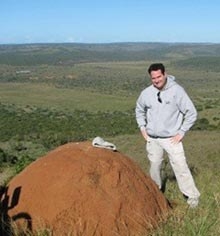UC Davis scientists share perspectives on endangered species
You don't have to dig too deep into the scientific literature and popular media to find perspectives on threats posed to biodiversity in California and around the globe. Two UC Davis scientists in the Department of Wildlife, Fish and Conservation Biology have published fresh insights into endangered species in recent months.
Endangered Species Act sets a high standard
Peter Moyle, professor in the Department of Wildlife, Fish and Conservation Biology, is a renowned expert on California's native fish. He used the occasion of the 40th anniversary of the passage of the federal Endangered Species Act (ESA) in December 2013 to size up how the act influenced his own research and how some of California's aquatic biota have fared.
After passage of the ESA, Moyle and his graduate students initially searched for three species they suspected were in trouble: Modoc sucker, rough sculpin and bull trout. They found the sucker in trouble but easy to protect, the sculpin reasonably secure, and the bull trout near extinction in California. It has since vanished.
"As an untenured professor then, I thought it a bit risky to base a career on finding rare fish," Moyle wrote in an opinion piece published in The Sacramento Bee. “So I also undertook a study of Delta and longfin smelt, which at the time were two of the most abundant fish in the Sacramento–San Joaquin Delta.”
Moyle began a monthly sampling program to keep track of smelt populations and other fish in the Suisun Marsh. A few years later smelt counts dropped dramatically. The data eventually led to the U.S. Fish and Wildlife Service listing the Delta smelt as a “threatened” species under the ESA.
His ongoing research has recorded a statewide decline of most native fishes. With other researchers, Moyle has just completed detailed accounts of the biology and status of more than 60 native fishes — all potential candidates for ESA listings. This study will soon be released by the California Department of Fish and Wildlife.
“Most of our recommendations for preventing extinctions call for more and better water for the fish, or at least for protecting existing water they depend on,” Moyle said. “Funny how it almost always comes down to fish needing water.
“The Endangered Species Act sets a high standard in this regard because it not only forbids extinction; it also mandates recovery of each species to a more sustainable state.”
Moyle's opinion piece can be viewed in its entirety here.
Human longevity an indicator of endangered species
Aaron Lotz is a postdoctoral scholar who has previously worked with other UC Davis scientists in the development of conservation and management plans for reptiles and amphibians in California. Recently he was involved in a study published last fall in the journal Ecology and Society on the social and ecological predictors of global invasions and extinctions.
The researchers analyzed data from 100 countries, representing 87 percent of the world's population. They examined 15 social and ecological variables, such as tourism, per capita gross domestic product, water stress and political stability. The study showed that as human life expectancy increases, so does the percentage of invasive and endangered birds and mammals.
“It's not a random pattern,” Lotz said. “Out of all this data, that one factor — human life expectancy — was the determining factor for endangered and invasive birds and mammals.”
New Zealand, the United States and the Philippines had among the highest percentages of endangered and invasive birds. The study has been reported in the Los Angeles Times and other news media. Read more about the study's findings in our news release here. The journal article can be viewed here.
Comments:
I contacted Professor Moyle about your comment. Here is his response:
The standard set by the ESA is a minimum standard: no extinction. But while we Americans seem to like the idea of the ESA, because it protects noble creatures like the bald eagle, we also make it difficult for the ESA to work effectively. The agencies in charge of listing species and enforcing the act are greatly understaffed and they are expected to adhere to extremely high standards of information for each listing, greatly limiting what they can do. It is astonishing that more species have not gone extinct since the ESA was created but this record is not likely to last long, as rapid environmental change overwhelms the ability of the agencies to keep up with the declining biota. It would be ideal if we could do more to prevent species from even reaching the point where the ESA kicks in but programs that would create such ecosystem protection projects are an anathema in this era of budget cuts that hit environmental agencies especially hard.




That's something that many people have an opinion on, but Moyle is in a rare position to have an informed viewpoint.
Posted by danielle on January 20, 2014 at 2:03 PM